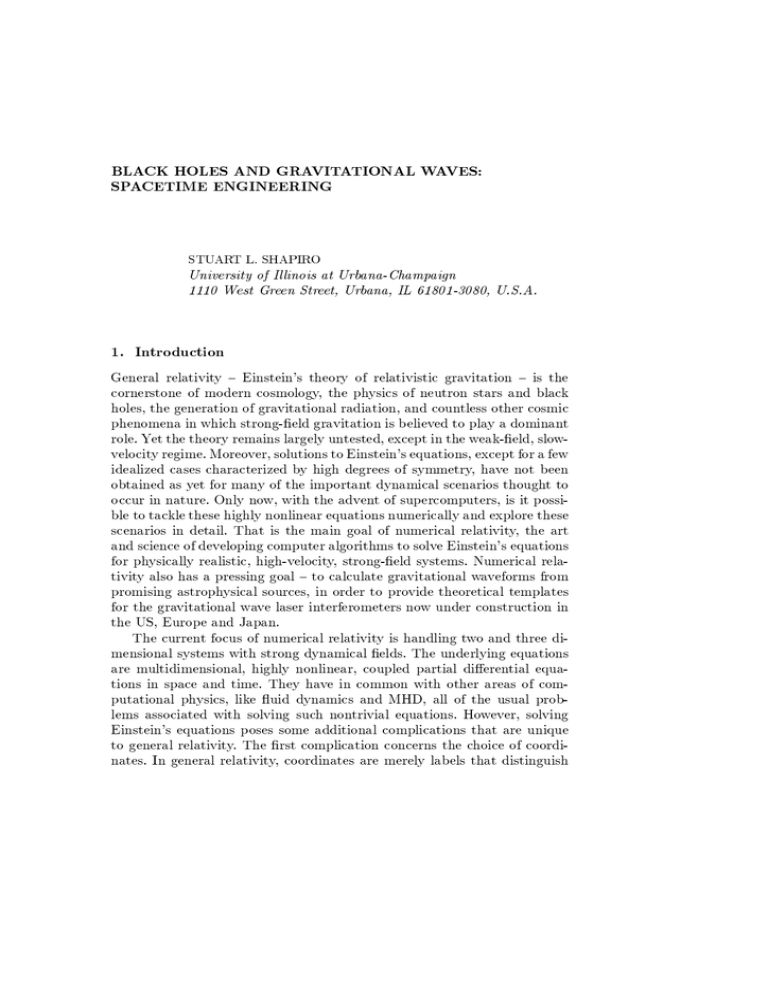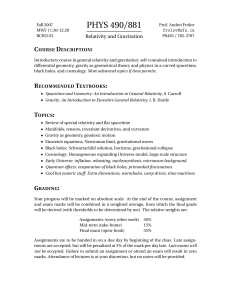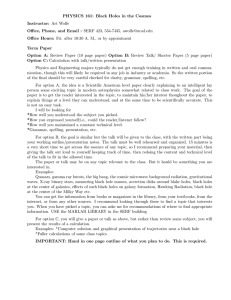BLA CK HOLES AND
advertisement

BLACK HOLES AND GRAVITATIONAL WAVES:
SPACETIME ENGINEERING
STUART L. SHAPIRO
University of Illinois at Urbana-Champaign
1110 West Green Street, Urbana, IL 61801-3080, U.S.A.
1. Introduction
General relativity { Einstein's theory of relativistic gravitation { is the
cornerstone of modern cosmology, the physics of neutron stars and black
holes, the generation of gravitational radiation, and countless other cosmic
phenomena in which strong-eld gravitation is believed to play a dominant
role. Yet the theory remains largely untested, except in the weak-eld, slowvelocity regime. Moreover, solutions to Einstein's equations, except for a few
idealized cases characterized by high degrees of symmetry, have not been
obtained as yet for many of the important dynamical scenarios thought to
occur in nature. Only now, with the advent of supercomputers, is it possible to tackle these highly nonlinear equations numerically and explore these
scenarios in detail. That is the main goal of numerical relativity, the art
and science of developing computer algorithms to solve Einstein's equations
for physically realistic, high-velocity, strong-eld systems. Numerical relativity also has a pressing goal { to calculate gravitational waveforms from
promising astrophysical sources, in order to provide theoretical templates
for the gravitational wave laser interferometers now under construction in
the US, Europe and Japan.
The current focus of numerical relativity is handling two and three dimensional systems with strong dynamical elds. The underlying equations
are multidimensional, highly nonlinear, coupled partial dierential equations in space and time. They have in common with other areas of computational physics, like uid dynamics and MHD, all of the usual problems associated with solving such nontrivial equations. However, solving
Einstein's equations poses some additional complications that are unique
to general relativity. The rst complication concerns the choice of coordinates. In general relativity, coordinates are merely labels that distinguish
258
STUART L. SHAPIRO
points in spacetime; by themselves coordinate intervals have no physical signicance. To use coordinate intervals to determine physically measureable
(proper) distances and times requires the spacetime metric, but the metric
is determined only after Einstein's equations have been solved. Moreover,
as the integrations proceed, it often turns out that the original (arbitrary)
choice of coordinates turns out to be bad, because, for example, singularities
eventually are encountered in the equations. The gauge freedom inherent
in general relativity { the ability to choose coordinates in an arbitrary way
{ is not always easy to exploit successfully in a numerical routine.
Another complication arising in numerical relativity involves the appearance of black holes. Black holes inevitably contain spacetime singularities { regions where the gravitational tidal eld, the matter density and
the spacetime curvature all become innite. Encountering such singularities results in some of the terms in Einstein's equations becoming innite,
causing overows in the computer output and premature termination of the
numerical integration. Thus, when dealing with black holes, it is crucial to
choose a technique which avoids the spacetime singularities inside.
Finally, one of the main goals of a numerical relativity simulation is to
determine the gravitational radiation generated from a dynamical scenario.
However, the gravitational wave components usually constitute small fractions of the background spacetime metric. Moreover, to extract the waves
from the background requires that one probe the spacetime in the far-eld
or radiation zone, which is typically at large distance from the strong-eld
central source. Yet it is the strong-eld region which usually consumes most
the computational resources (e.g spatial grid) to guarantee accuracy. Furthermore, waiting for the wave to propagate to the far-eld region usually
takes nonnegligible integration time. Overcoming these diculties to reliably measure the wave content thus requires that a code successfully cope
with the problem of dynamic range inherent in such a simulation.
2. The Grand Challenge Eorts
The most outstanding unsolved problem in classical general relativity is the
two-body problem. Consequently, signicant computational eort is going
into solving the coalescence of binary black holes and binary neutron stars.
Obtaining the fully dynamical solutions to these scenarios is not only of
theoretical interest, but it is also crucial to gravitational wave astronomy,
since coalescing binaries are the most promising sources of gravitational
waves detectable by the laser interferometers now being built. So important
is this eort that in the US, both the NSF and NASA have funded Grand
Challenge teams of computational physicists and computer scientists to
work on these binary coalescence problems.
SPACETIME ENGINEERING
259
The `holy grail' of these Grand Challenge eorts is the calculation of
the complete gravitational waveform in each of the two polarization states,
h+ and h2 , from binary inspiral and coalescence. Having the theoretical
waveform as a template is crucial to the `matched lter' technique of gravity wave detection by the laser interferometers under construction. It is
also important for using the observed waveforms to probe the strong-eld
geometry around coalescing neutron stars and black holes.
Despite the importance of solving the coalescence problem and the intensive eort to date that has gone into obtaining the answer, no computer
code currently exists that can integrate two black holes or two neutron stars
in binary orbit long enough to get a waveform out to an accuracy anywhere
near 10%. Nevertheless, considerable progress has been achieved. A number
of computer modules crucial to solving the problem on parallel machines
have been assembled and tested. Some new physical insights have emerged
from simulations performed to date (see Section 3). Additionally, new formulations of Einstein's equations have emerged which recast them into
a ux-conservative, rst order, hyperbolic form where the only nonzero
characteristic speed in that of light; (Choquet-Bruhat and York, 1995;
Abrahams et. al., 1995). As a consequence, these equations may permit
a more reliable \excision" of black holes and their nasty interior singularities from the numerical grid and the replacement of these regions by a
well-behaved boundary condition (\horizon boundary conditions").
3. Applications: Topology of a Black Hole Event Horizon
Two denitive results that emerged from the early phase of the Binary Black
Hole Grand Challenge work have to do with the topology of the black hole
event horizon. The event horizon is the surface of a black hole; events which
occur inside cannot be seen from the outside because nothing can escape
the interior, including light signals. The rst result of the simulations dealt
with the event horizon formed from the merger of two identical, nonspinning
black holes which collide head-on. The second dealt with the formation of
the event horizon from the collapse of a rotating toroid. Both results were
obtained by performing simulations with a mean-eld, particle simulation
code in axisymmetry (Shapiro and Teukolsky, 1992; Abrahams et. al., 1994).
The code solved the collisionless Boltzmann equation for the matter by
integrating particle geodesic equations in the mean gravitational eld of
the distribution. The matter provided the source terms for the gravitational
eld (ADM) equations, which were solved by nite dierencing.
260
3.1.
STUART L. SHAPIRO
HEAD-ON COLLISION AND COALESCENCE OF TWO BLACK HOLES
Consider the the head-on collision of two identical clusters of collisionless
particles (Shapiro and Teukolsky, 1992). These particles may represent stars
in a cluster, or any other form of collisionless matter which interacts exclusively by gravity. At t = 0 the velocity dispersion in each cluster is zero, so
that each cluster collapses on itself to form a black hole prior to merger. In
this way we set up a simulation of a head-on collision of black holes.
In Figure 1 we show spatial snapshots of the collision at three dierent
instants of time. The upper gure shows the initial congurations, which
are hurling towards each other at velocity v = 0:15c. The middle frame
shows the formation of two black holes from the collapse of each of the
clusters. Note how the tidal eld of the companion causes a distortion in
the shape of the black hole, giving rise to the \hour glass" appearance of the
merging holes when they rst come into contact. The bottom frame shows
the conguration at late times, when the two black holes have coalesced into
a single, spherical Schwarzschild hole which encompasses all of the matter.
Figure 2 is a spacetime diagram of the collision and merger. The time
axis is along the vertical direction, while spacelike hypersurfaces (with one
of the spatial directions suppressed) are horizontal planes at any instant of
time. The collision axis goes from left to right and the black hole horizon
is shown as the dark shaded surface. Some of the light rays which generate
the horizon (\null generators of the horizon") are shown. Their trajectories
were traced by numerically propagating light rays in the background curved
spacetime. The inset shows a closeup view of the formation and merger of
the two horizons and how the rays enter the horizons at those early events.
Figure 2 is the famous \pair of pants" picture of the event horizon for
coalescing black holes that was sketched in general relativity textbooks
more than 25 years ago (Hawking and Ellis, 1973; Misner et. al., 1973).
The gure shown here is the rst real calculation of such a diagram. Many
things were known about the the topology of the merging horizons and the
null generators prior to these numerical simulations, but a few important
details were not. It was well known that the black hole is spanned by null
generators, which can intersect or cross each other only at those points at
which they enter the horizon. Once on the horizon, a null generator can
never propagate o, nor can it ever cross another null generator. These
properties were all understood and nicely corroborated by the simulation.
But in addition, the simulation revealed for the rst time a line of crossover
points for the null generators extending from the \crotch" on the \pair of
pants" down along each inside trouser seam, around each bottom, and continuing a small distance up each outside \seam" (see Figure 2). The points
on the outside seam at which the line of crossover terminates are caustics,
SPACETIME ENGINEERING
261
The collision and coalescence of two black holes formed by the collapse of two
spheres of particles. The black hole event horizon is shown by the dark shaded surface.
The clock in each snapshot indicates the fraction of time elapsed during the simulation.
Figure 1.
where the intensity of the intersecting light rays becomes innite. For a
single, isolated cluster undergoing spherical collapse to a black hole, the
caustic would arise at the base of the spacetime diagram at the point at
which the horizon rst forms, and there would be no crossovers. Here, the
gravitational tidal eld of the colliding black holes shifts the location of
the caustic and produces the line of crossovers. An analysis of the simulation (Matzner et. al., 1995) shows that the line of crossovers is spacelike,
which means that they cannot be traced by light rays or particles moving
slower than c. As this line approaches the caustics on the sides, it becomes
asymptotically light-like.
262
STUART L. SHAPIRO
Spacetime diagram for the collision shown in Figure 1. Some of the light rays
generating the horizon are drawn. The collision axis goes from left to right and the time
axis is vertical. The inset is a blow up of the caustic and crossover structure at the birth
of the horizon.
Figure 2.
3.2.
TOROIDAL BLACK HOLES AND TOPOLOGICAL CENSORSHIP
Consider the collapse of rotating toroidal clusters of collisionless particles
to Kerr black holes. One of the interesting ndings of our numerical simulations was a case in which the black hole event horizon emerges as a toroid
(Abrahams et. al., 1994; Hughes et. al., 1994). The initial matter distribution is based on a solution for a relativistic toroidal cluster in dynamical
equilibrium. Collapse was induced by reducing the angular velocity of each
particle by a factor of two, resulting in a nonequilibrium cluster with a total
angular momentum of J=M 2 = 0:7.
The spactime diagram for the collapse looks quite similar to the diagram
plotted in Figure 2. The line of crossover points at which light rays enter
the horizon, and the cusp formed by rays at the point at which the line of
crossovers terminates, are all present as in Figure 2. The toroidal horizon
rst forms entirely within the vacuum, between the origin and the inner
edge of the collapsing, toroidal cluster. The horizon then expands to ll up
the \doughnut hole," becoming topologically spherical at about the instant
when the outer edge of the horizon reaches the inner edge of the matter
toroid.
When the results of the numerical simulation were rst reported, it
appeared that they might be in conict with recent theorems regarding
\topological censorship." These theorems permit a nonstationary black hole
to have the topology of a two-sphere or a torus (Gannon, 1976), but a
torus can persist only for a short time. According to topological censorship
(Friedmann et. al., 1993; Jacobson and Venkataramani, 1995) the hole in a
SPACETIME ENGINEERING
263
toroidal horizon must close up quickly, before a light ray can pass through.
Moreover, the black hole must be two-sphere if no null generators enter the
horizon at later times (Browdy and Galloway, 1995).
Once the numerical simulations were studied in detail and the geometry of the transient toroidal event horizon was analyzed by means of a
spacetime diagram like Figure 2, the results were shown to be completely
consistent with the theorems concerning the topology of black hole horizons
(Shapiro et. al., 1995). At late times, when equilibrium has been reached,
the topology is spherical, in agreement with the theorem of Hawking (1972).
At early times, the topology is temporarily toroidal. However, the line of
crossovers traced out by a point on the inner rim of the torus is spacelike.
That implies that the \hole" in the torus indeed closes up faster than the
speed of light, in compliance with topological censorship. Finally, at intermedidate times, when the horizon is spanned by its full complement of null
generators, the rotating black hole has a spherical topology, in accord with
the theorems of Browdy and Galloway (1995).
4. Conclusions
Numerical relativity is only in its infancy, or at most very early adolescence.
It is still under development as a valuable scientic tool to solve Einstein's
equations of general relativity for realistic, dynamical spacetimes involving
strong-eld sources like black holes. Already it has been used successfully
to determine gravitational waveforms for simple cases characterized by high
degrees of spatial symmetry, like head-on collisions and axisymmetric collapse. Its renement is absolutely crucial for interpretating the waveforms
likely to be observed by the new gravitational wave laser interferometers
now under construction, like LIGO, VIRGO, GEO and TAMA. These waveforms will arise from the inspiral and coalescence of binary black holes and
neutron stars.
Numerical relativity has also demonstrated that beyond the calculation
of accurate numerical solutions, it can provide qualitative insight into Einstein's equations in those cases where uncertainty still prevails. It can even
be helpful as a guide to proving (or disproving) theorems about strong-eld
spacetimes in those instances where analytic means alone have not proven
adequate. Numerical relativity is an important component of modern computational astrophysics whose role is likely to mushroom in the not too
distant future.
References
Abrahams, A., Anderson, A., Choquet-Bruhat, Y. and York, J. W., Jr. (1995)
Lett., 75, p 3377.
Phys. Rev.
264
STUART L. SHAPIRO
Abrahams, A., Cook, G. B., Shapiro, S. L. and Teukolsky, S. A. (1994) Phys. Rev. D,
49, p 5153.
Browdy, S. and Galloway, G. J. (1995) J. Math. Phys., 36, p 4952.
Choquet-Bruhat, Y. and York, J. W., Jr. (1995) C. R. Acad. Sci., Ser. I: Math., A321,
p 1089.
Friedmann, J. L., Schleich, K. and Witt, D. M. (1993) Phys. Rev. Lett., 71, p 1486.
Gannon, D. (1976) Gen. Relativ. Gravit., 7, p 219.
Hawking, S. W. (1972) Commun. Math. Phys., 25, p 152.
Hawking, S. W. and Ellis, G. F. R., The Large Scale Structure of Spacetime, (Cambride
Univ. Press, Cambridge, 1973).
Hughes, S. A., Keeton, C. R., Walker, P., Walsh, K., Shapiro, S. L. and Teukolsky, S. A.
(1994) Phys. Rev. D, 49, p 4004.
Jacobson, T. and Venkataramani, S. (1995) Class. Quantum Grav., 12, p 1005.
Matzner, R. A., Seidel, H. E., Shapiro, S. L., Smarr, L., Suen, W.-M., Teukolsky, S. A.,
and Winicour, J. (1995) Science, 270, p 941.
Misner, C. W., Thorne, K. S., and Wheeler, J. A., Gravitation, (Freeman, San Francisco,
1973).
Shapiro, S. L. and Teukolsky, S. A. (1992) Phys. Rev. D, 45, p 2739.
Shapiro, S. L., Teukolsky, S. A. and Winicour, J. (1995) Phys. Rev. D, 52, p 6982.




